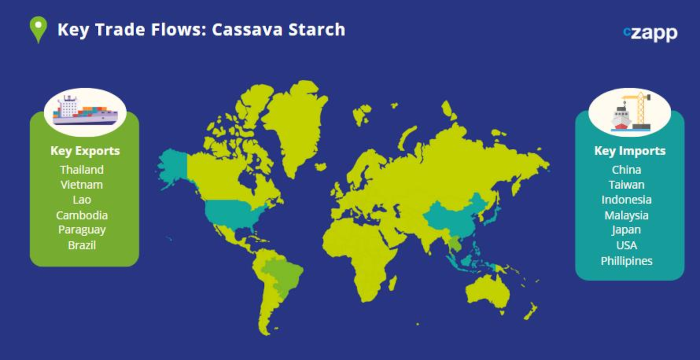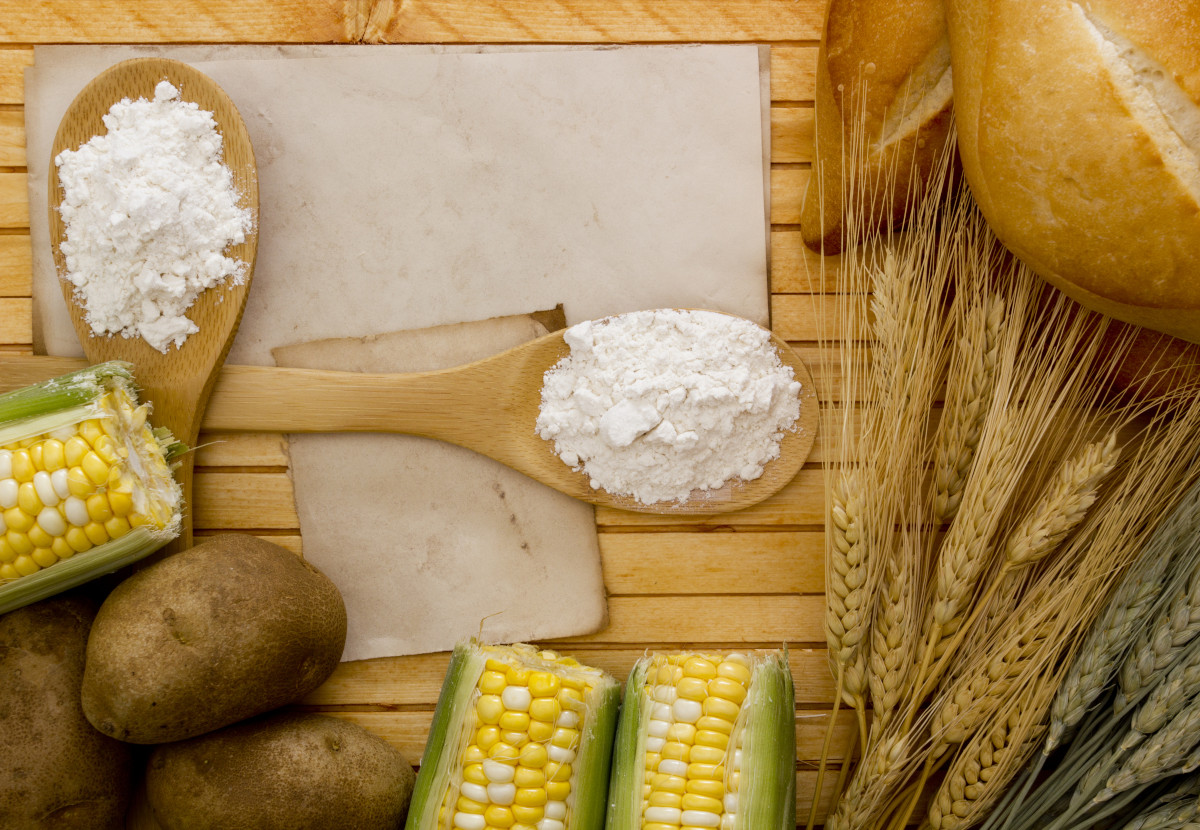Used widely as an ingredient, starches are present in almost everything we eat. But what are they and where do they come from?
What are starches?
Starch is a naturally occurring carbohydrate composed of long chains of glucose molecules. The majority of green plants store energy in the form of starch, making it the most common type of carbohydrate in both our and their diets.
Starch is primarily extracted from corn, wheat, tapioca, potatoes, rice, and other plant feedstocks. Each raw ingredient yields a different amount of starch, which varies greatly. While 1kg of corn yields 0.625kg of corn starch, 1kg of potatoes yields 0.20kg of potato starch.
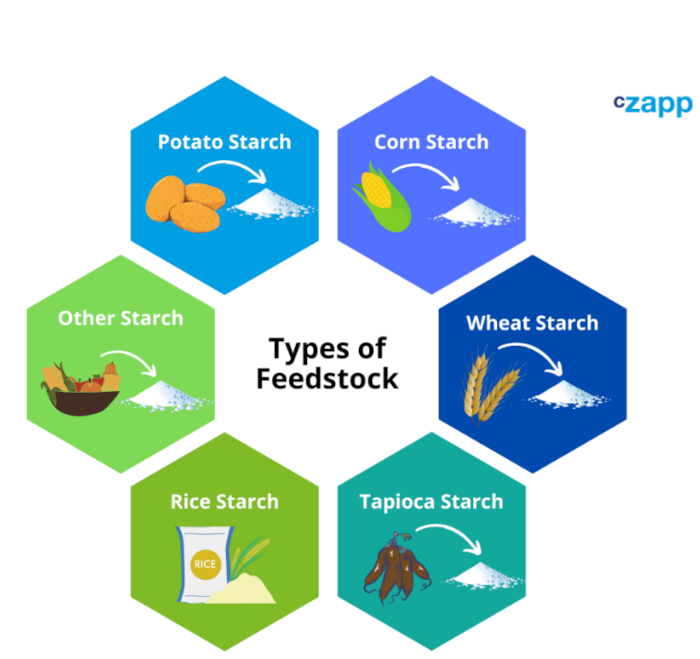
In general, starches are a tasteless and odourless white powder, impossible to distinguish with the human eye. As any cook who has thickened a sauce with corn flour will know, they are insoluble in cold water, but when heated in water, the starch structure starts to break down, increasing the mixture’s viscosity.
Starches can also be broken down into smaller molecules through hydrolysis, commonly by fermentation, using enzymes or through chemical methods.
Starches have been used throughout history and are now most commonly used in the food and paper industries. They are especially useful in the food industry where they can play a number of different roles.
When used as a food additive, starch can be classified as “Native” or “Modified,” but it can also be used to make sweeteners such as Dextrose and corn syrups.
Native Starch
These are the purest forms of starch because they are obtained by grinding the feedstock, washing to extract the starch, and then drying to form the starch powder.
Native starches serve as thickeners, binding/gelling agents, and/or to achieve the desired appearance and texture of the final product.

Modified Starch
Once extracted, starches can undergo additional processing to produce modified starches, each with unique properties depending on the feedstock from which the starch was derived. Despite the additional processing, these are typically regarded as natural ingredients.
Modified starches fulfil a similar purpose as their native equivalent yet improved. Modified starches are better suited for the modern food processing industry as they can provide improved resistance to higher and frozen temperatures as well as providing unique textures.
Sweeteners
Long chains of starch can be broken into smaller components through a process known as hydrolysis. This can be accomplished through the use of enzymes, fermentation, or other chemical methods, resulting in the production of dextrins or starch sugars.
Maltodextrin is a lightly hydrolysed starch product that is commonly used as a thickener. Dextrose is a fully hydrolysed starch product: in other words, the starch chains have been fully broken down into their glucose units. Dextrose/glucose is used as a sweetener.
Between the two extremes there exist many different glucose syrups of varying sweetness and thickness. In addition, if the dextrose solutions are treated with the enzyme glucose isomerase, a substantial proportion of the glucose can be converted to fructose to yield high fructose corn syrups (HFCS).
How are they made?
Crop feedstocks are wet-ground and processed to remove plant proteins, fibres, and germ, leaving a starch slurry. This slurry is dried to obtain native starch or treated through physical, chemical, or enzymatic means to become modified starch or starch sweeteners. In some cases, the paste is also fermented to make ethanol.
Nevertheless, most of the paste is destined to produce sweeteners. Through hydrolysis starch paste is broken into smaller molecules to obtain glucose syrups and other sweeteners.
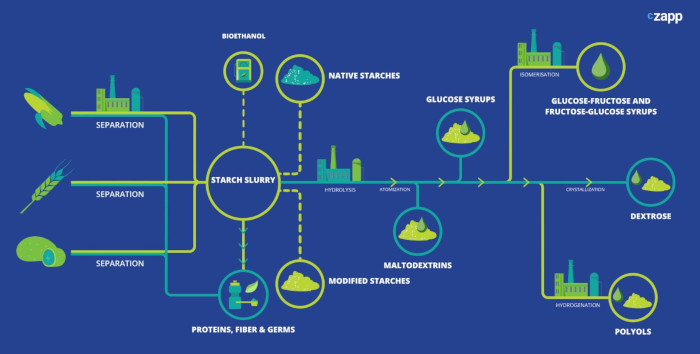
Source: European Starch Association
Industry Application
Starches play a critical role in various industries as the food, chemical and packaging. Each starch has different properties which makes it suitable for different uses.
Food
The food industry uses native and modified starches as a key ingredient to achieve the desired end product’s look and characteristics according to the manufacturer’s preference. Widely used in savoury and confectionary products as well as in sauces.
Modified starches will be present in most frozen foods, “ready meals” and specialty foods.
Packaging
Modified starches binding properties make them a critical input in the paper and corrugating industry as an adhesive.
Pharmaceutical & Chemical
Starch binding and dissolvent properties are suitable in the formulation of tablets and capsules by pharmaceuticals. Moreover, starches are amongst the few natural ingredients that are fit for human consumption, relatively cheap and easily accessible with little processing.
Starch is used in the chemical industry to produce amino acids, organic acids, enzymes, and yeast.
Feed
Besides some starch going into the feed industry, most feed is produced from the co-products separated at the beginning of the process.
Other uses:
- Textiles,
- Glue,
- Bioplastics,
- Detergent industry,
- 3D printing ink
Key Trade Flows
Starch trade flows are determined by the availability of raw materials.
Corn (Maize)
According to the USDA, US corn is facing increased competition from Ukraine, Argentina, and Brazil, as US corn prices are currently higher than Ukrainian and Argentine corn, owing to increased domestic demand for fuel ethanol in the US, resulting in lower exports compared to previous years.
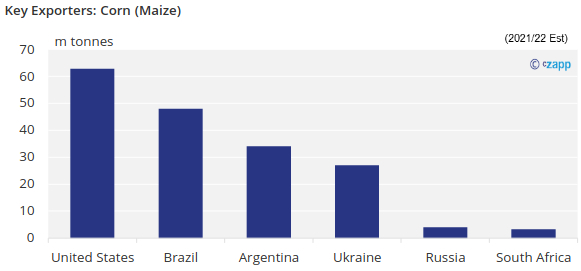
Source: USDA, 2023
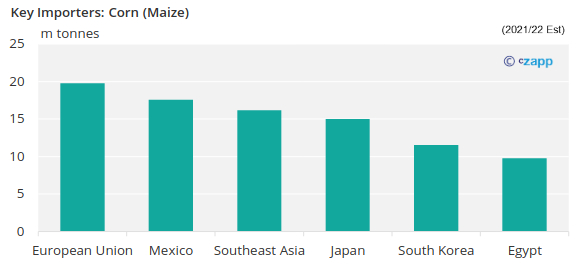
Source: USDA, 2023
Now turning our attention to the starch market, it appears that the majority of global starch markets are dominated by corn (maize), with key players located in China, India, Turkey, and the United States.
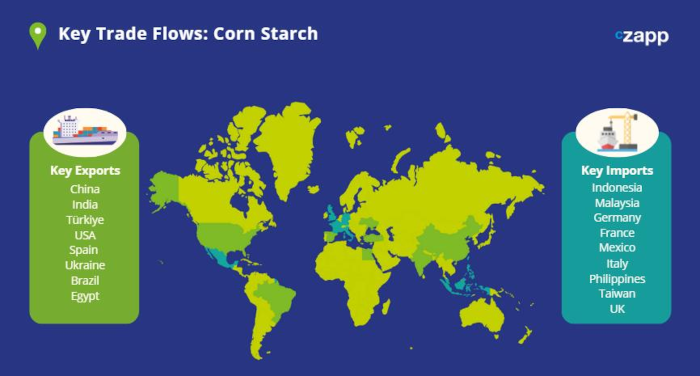
Wheat
After maize, wheat is the second most produced cereal grain. Together, Russia, Ukraine, and the rest of Europe account for almost a third of the world’s wheat trade.
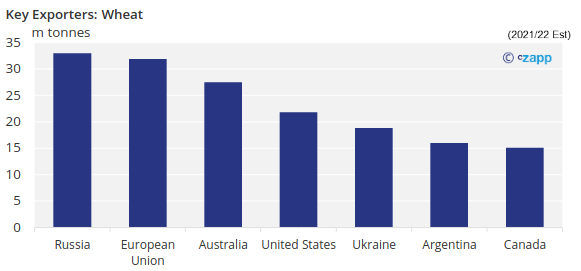
Source: USDA, 2023
According to the USDA, Australian exports are primarily destined for the large wheat-consuming markets of Southeast Asia and East Asia, where they can take advantage of their proximity and lower freight costs compared to their major competitors.

Source: USDA, 2023
With sufficient supplies arriving from Australia, imports of goods for China, Japan, Malaysia, South Korea, Taiwan, Thailand, and Vietnam are rising.
According to the map below, Europe appears to dominate the global wheat starch market, accounting for two-thirds of the industry.

Cassava
Although cassava is widely produced in Latin America and Africa, the majority of the world’s trade flows are in South and East Asia, with Thailand and Vietnam being the biggest exporters.

Source: FAOSTAT, 2020
In 2020, Thailand exported 2.73 million tonnes of cassava starch, and Vietnam exported 2.13 million tonnes. The majority of these exports go to China, where they are used to produce ethanol and animal feed.

Source: FAOSTAT, 2020
Southeast Asia continues to be the world’s top producer of cassava starch; however, the market landscape is changing, with Latin America and Africa seeing an increase in cassava starch production.
